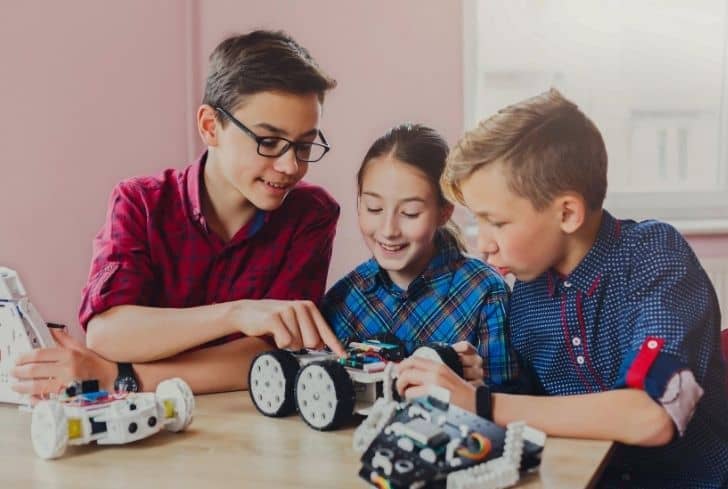Robotics for kids involves introducing kids to the science and technology involved in building robots. Kids learn how to build robots from scratch. They practice STEM concepts in a fun way.
Robotics classes are not for kids who are geniuses alone. They are for every kid, irrespective of their learning speed or cognitive ability.
Continue reading to know more about robotics for kids!
What is Robotics?
Table of Contents
Years back, in robotics, those running the show were adults. No one bothered to ask, “What do kids do in a robotic class” because it wasn’t so commonplace for kids. Today, things are quite different. There are numerous robotic classes for kids being organized across the globe.
Now, what is robotics? If you’re just hearing the term for the first time, it makes sense to know what it is.
Robotics is a branch of technology focused on building, programming, and designing robots. It’s an excellent way to educate and introduce kids to technology.
Is Robotics Good For Kids?
The term “robotics” seems like a sophisticated technology, no doubt. And as such, many may conclude that robotics might be too complicated for kids, most especially in their formative years.
So here goes the big question. Is robotics good for kids? Our society needs problem solvers. It needs people who are critical thinkers and can analyze different situations. We have gone past the stage where age can limit one’s academic exploit. Children of this age have a high tendency to achieve greater things.
So, robotics is ideal for kids. Besides allowing kids to learn STEM in a fun way, it can make them better individuals. In robotic classes, kids learn how to build robots from scratch.
Exposing kids to such technology early in life can help boost their mental capacity. It will enable them to build strong cognitive abilities to scale through life’s challenges.
Another reason robotics is good for kids is that it makes learning engaging and fun. It let kids see that there are rewards in learning, instead of viewing it as a punishment. It makes them see the bright side of education and how it can change lives.
So robotics is excellent for kids in diverse ways. It can help societies to raise mentality sound and smart kids that love learning.
It’s never too early for a child to learn robotics. Even if that child can’t read properly, he or she can learn basic coding concepts.
How Do You Explain A Robot To A Child?
Kids are fascinated by robots. They treat them as play buddies. However, just because a kid has a massive collection of robots doesn’t mean he or she knows what a robot is. To kids, robots are just playing toys and nothing more.
For a child to learn and build sound knowledge in robotics, he or she must know and appreciate what a robot is. It’s one of the first things that kids in a robotics class need to understand before they dive into the technology proper.
The first step is to define what a robot is. Let the kids know that robots are more than play toys.
By definition, a robot is a machine that performs tasks automatically. Not all robots resemble humans.
A robot can only do what it has been programmed to do. It can’t decide on its own.
Various Parts of a Robot
Here’s another area you should focus on when explaining robots to kids.
First, a robot can be built from diverse materials, such as plastics and metals. It is also composed of three parts.
Here are the parts robots have;
- The controller – Here’s the robot’s brain, run by a computer program. The brain controls the robot, just like humans. In robots, the controller, aka brain, gives commands that the robot’s moving parts execute.
- Mechanical parts – By mechanical parts, we mean parts that make it possible for the robot to lift, turn, move, and grab on to things. These include pistons, motors, wheels, and grippers.
- Sensors – These are also vital parts of a robot. It makes the robot aware of its surrounding. Sensors enable robots to determine shapes, sizes, directions, and even spaces between two objects.
Robots And Their Limitations
Your explanation about robots would not be complete without stating the positive and negative impacts of robots.
Children are smarter than we sometimes view them. So, telling them about the limitations and pros of robots won’t get them confused. It might even help them to understand what robots are.
Now, what are the limitations of robots? Most movies make robots seem like they are intelligent and capable of making logical decisions. We can’t blame the producers of such movies anyway. But kids need to know that robots are far from what those movies portray.
Here are some of the limitations robots have;
- Inability to respond in times of danger – Robots will always be robots unless things change in years to come, which is possible. Then, we may have robots that think and act like humans. Robots can’t respond to dangers unless commanded via a computer program.
- Limited functionality – Here’s one area where robots fail woefully. Robots can do defined jobs correctly but can’t handle unexpected tasks in the same manner that humans do.
- Lack of a conscience – Robots do not have a consequence. They lack empathy and all the benefits that go with it. And this affects their ability to interact with people smoothly.
- Colonization – Yes, robots can travel to the moon and other planets, in place of humans. The only major issue in this is that they cannot build an independent and functioning society.
Why Robots Are Important – Pros of robots
When you’re explaining robots to children, stress on their limitations and relevance. Don’t be one-sided in your explanation. Let the kids know the limitations and advantages robots have.
Here are some pros of robots;
- The tasks robots can perform are now becoming vast.
- Robots can work 24/7 without getting tired.
- Robots are useful in various fields. They have been used to perform medical surgery successfully.
- Robots can be more precise than humans.
- Robots don’t complain or get tired. You can have any of their parts replaced once worn out.
- Robots are cheaper to use in some jobs than humans. They can also deliver increased output.
- Robots can handle materials or move to places considered dangerous for humans.
How do Robots Work?
You should also explain how robots work to kids learning robotics. Understanding the concept might boost their interests.
So how do robots work? Many of the robots are computer-controlled devices that have numerous parts.
You can teach an industry robot movement needed to perform a specific task. The robot’s sensor would then send signals about the actions to the computer, which stores them.
The computer can then use the movement patterns stored to instruct the robot on actions to take.
What Do Kids Do in A Robotic Class?
Robotics kits help connect mathematics and science to the real world. They allow children to witness scientific theories first-hand.
Unlike educational software and apps, robotics classes for kids don’t involve sitting alone, in front of a computer system. Robotics classes are more engaging. Every single child in a robotics class gets involved, one way or another.
In a robotics class, kids learn the basics of robotics. They learn the meaning, how robots work, various parts, and other essential information about robots.
After learning and getting acquainted with the basic information on robots, children can proceed to learn how to make, design, and program robots. They engage in practical work.
However, before the practicals, kids are put through the theoretical aspects. This gives them sound knowledge on robotics as they proceed.
In a robotics class, once the kids finish learning the theoretical and practicals, they are given light robotics projects to strengthen their knowledge.
So, the primary thing kids do or learn in a robotics class is to build robots. But it’s a process. They can’t build robots overnight.
5 Things Kids Can Learn From a Robotics Program
- Problem-solving skills –Robotics program gives kids the chance to understand how robots work. Assembling a robot isn’t an easy task. The kids have to rack their brains a bit to put each part together. By so doing, they’re building solid problem-solving skills.
- Advanced robotics program can help kids to build solid Computer programming skills
- A robotics program can facilitate math and science learning in the classroom.
- Robotics program enables children to socialize and understand the power of teamwork.
- The robotics program introduces children to programming. They learn to code and build robots in a fun way.
Conclusion
Allowing your kids to partake in robotics classes will benefit you as a parent and do likewise to your children in the future. What your kids would learn in a robotics class can impact them academically, positively. Robotics for kids is also a good and positive way to introduce children to technology. They’ll also pick up diverse soft and hard skills, along the line.







